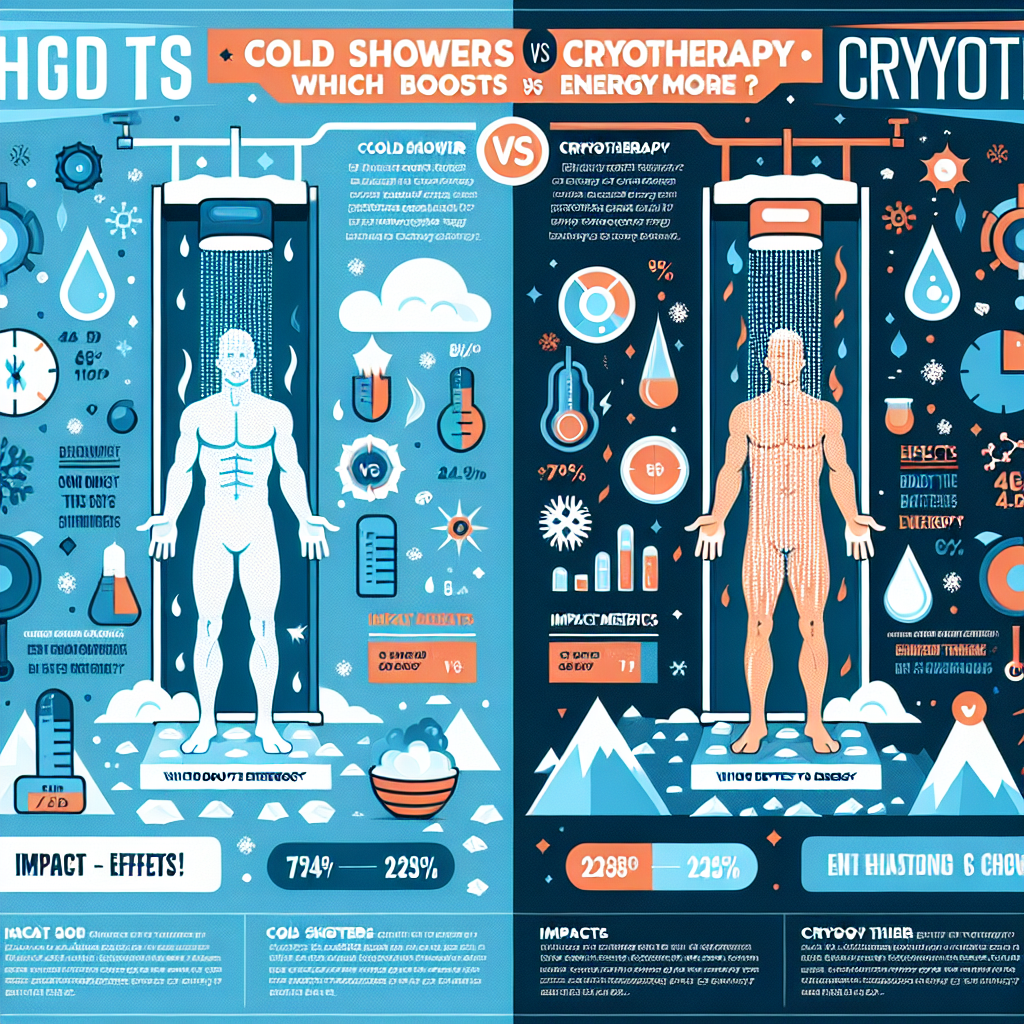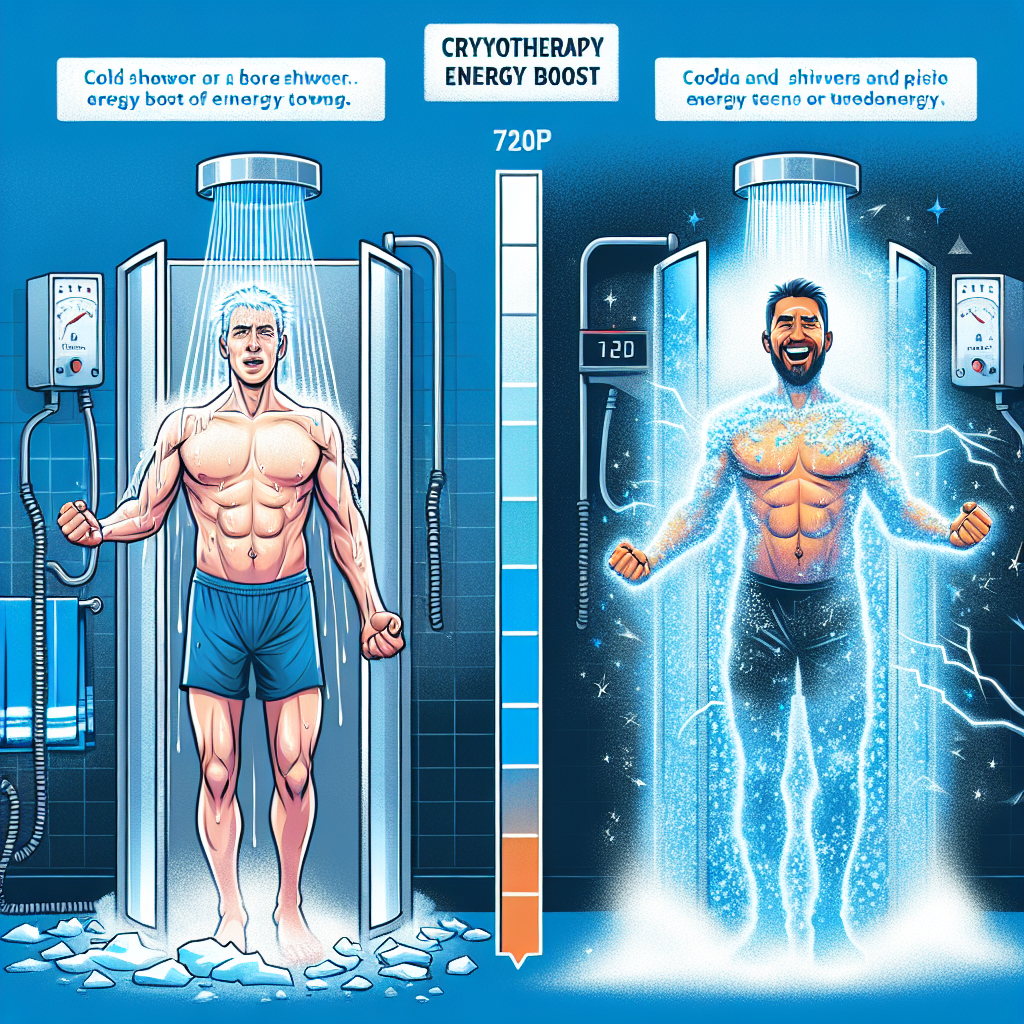Cold Showers vs Cryotherapy: Which Boosts Energy More?

Discover the energy-boosting benefits of cold showers and cryotherapy! Which one gives you more vitality? Find out now and elevate your wellness routine. Visit My Vibrant Vitality today.
Comparing Energy Boosting Effects: Cold Showers vs Cryotherapy
Cold showers and cryotherapy are two popular methods used by many to boost energy levels. Both involve exposure to cold temperatures, but they differ in their application and intensity. This article aims to compare the energy-boosting effects of cold showers and cryotherapy, providing insights into which method might be more effective.
Cold showers, a practice that dates back to ancient times, are known for their invigorating effects. The sudden exposure to cold water triggers a rush of blood through the body, stimulating the circulatory system and increasing heart rate. This physiological response results in a surge of energy, helping to shake off feelings of fatigue. Moreover, cold showers are believed to stimulate the production of endorphins, the body’s natural ‘feel-good’ hormones, which can further enhance feelings of alertness and vitality.
On the other hand, cryotherapy is a more recent innovation in the realm of cold therapies. It involves exposing the body to extremely cold temperatures, often below -100 degrees Celsius, for a short period, typically two to four minutes. This is usually done in a controlled environment using a cryotherapy chamber. The extreme cold triggers a survival response in the body, causing it to divert blood flow to the vital organs. Once the session is over and the body starts to warm up, the blood rushes back to the extremities, delivering a boost of oxygen and nutrients. This process is believed to stimulate the production of adrenaline and endorphins, leading to an increase in energy levels.
While both cold showers and cryotherapy can boost energy, there are differences in their effects. The energy boost from a cold shower tends to be immediate but short-lived. It’s a quick and easy way to wake up in the morning or shake off a mid-afternoon slump. However, the effects usually wear off within a few hours.
Cryotherapy, on the other hand, may provide a more sustained energy boost. The extreme cold exposure triggers a more intense physiological response, which can lead to a longer-lasting increase in energy levels. Some people report feeling energized for the rest of the day after a cryotherapy session. Additionally, cryotherapy may have other benefits such as reducing inflammation, improving sleep, and aiding in muscle recovery, which can indirectly contribute to increased energy levels.
However, it’s important to note that cryotherapy is not as accessible or affordable as cold showers. It requires specialized equipment and trained professionals, making it less convenient for daily use. Moreover, while generally considered safe, cryotherapy can have side effects, especially for those with certain health conditions. Therefore, it’s essential to consult with a healthcare professional before starting cryotherapy.
In conclusion, both cold showers and cryotherapy can boost energy levels, but they do so in different ways and to varying degrees. Cold showers provide a quick, immediate energy boost and are easy to incorporate into daily routines. Cryotherapy, while potentially offering a more sustained energy increase, requires more resources and precautions. Ultimately, the choice between the two will depend on individual preferences, resources, and health considerations.
Cold Showers and Cryotherapy: Which Provides More Energy?

Cold showers and cryotherapy are two popular methods used by individuals seeking to boost their energy levels and improve their overall health. Both practices involve exposure to cold temperatures, but they differ significantly in their application and intensity. This article will explore the benefits of each method and determine which one provides more energy.
Cold showers, a practice that dates back to ancient times, are known for their invigorating effects. The sudden exposure to cold water triggers a rush of blood through the body, stimulating the circulatory system and increasing heart rate. This physiological response results in a burst of energy that can help kickstart your day or provide a midday pick-me-up. Cold showers also stimulate the production of endorphins, the body’s natural painkillers, which can lead to feelings of euphoria and positivity.
In addition to these immediate effects, regular cold showers can lead to long-term health benefits. They can improve skin and hair health by tightening pores and cuticles, and they can boost the immune system by increasing the production of white blood cells. Furthermore, cold showers can aid in weight loss by activating brown fat, a type of fat that burns calories to generate heat.
Cryotherapy, on the other hand, is a more recent development in the realm of cold therapies. It involves exposing the body to extremely cold temperatures, typically below -100 degrees Celsius, for a short period of time. This is usually done in a controlled environment such as a cryotherapy chamber.
The extreme cold triggers a survival response in the body, causing blood to flow away from the extremities and towards the vital organs in the core. This process increases the oxygen and nutrient supply to these organs, boosting their function and efficiency. Once you step out of the cryotherapy chamber, the blood rushes back to the extremities, flushing out toxins and delivering a surge of energy.
Cryotherapy also stimulates the production of endorphins and other ‘feel-good’ hormones, leading to a mood boost and increased mental clarity. It can also aid in muscle recovery, reduce inflammation, and improve skin health. However, it’s important to note that cryotherapy should be performed under professional supervision due to the extreme temperatures involved.
So, which of these two methods provides more energy? The answer largely depends on individual preference and tolerance to cold. Some people may find the intense cold of cryotherapy too uncomfortable, while others may not have access to a cryotherapy chamber. Cold showers, on the other hand, are easily accessible and can be adjusted to suit individual comfort levels.
In terms of immediate energy boost, cryotherapy may have the edge due to the extreme cold and the body’s survival response. However, the energy boost from a cold shower can be more sustainable and consistent if practiced regularly.
In conclusion, both cold showers and cryotherapy offer significant energy-boosting benefits. The choice between the two will depend on personal preference, accessibility, and tolerance to cold. As with any health practice, it’s important to listen to your body and choose the method that feels right for you.
The Battle for Energy: Cold Showers vs Cryotherapy
The quest for increased energy and vitality has led many to explore a variety of methods, from traditional exercise and diet regimens to more unconventional approaches. Among these, cold showers and cryotherapy have emerged as popular choices, each boasting a unique set of benefits. However, the question remains: which of these two methods is more effective in boosting energy?
Cold showers, a practice that dates back to ancient times, have been lauded for their ability to invigorate the body and mind. The sudden exposure to cold water triggers a rush of blood through the body, stimulating the circulatory system and increasing heart rate. This physiological response results in a natural energy boost, leaving one feeling alert and refreshed. Moreover, cold showers are known to enhance mood by triggering the release of endorphins, the body’s natural ‘feel-good’ hormones. This combination of physical invigoration and mood elevation makes cold showers a simple yet effective tool for energy enhancement.
On the other hand, cryotherapy, a more modern and technologically advanced method, involves exposing the body to extremely cold temperatures for a short period. This is typically achieved through the use of a cryotherapy chamber, where temperatures can drop to as low as -200 degrees Fahrenheit. The extreme cold stimulates the body’s survival mechanisms, leading to increased blood flow and the release of adrenaline. This adrenaline rush can result in a significant energy boost, along with improved focus and mental clarity. Additionally, cryotherapy has been linked to enhanced metabolic function, which can further contribute to increased energy levels.
While both cold showers and cryotherapy offer unique benefits, their effectiveness in boosting energy can vary based on individual factors. For instance, the intensity and duration of the cold exposure can significantly influence the energy-boosting effects. A brief, intense cold shower may provide an immediate energy boost, while a longer, more gradual exposure may result in a sustained increase in energy levels. Similarly, the duration and frequency of cryotherapy sessions can impact the extent of the energy boost experienced.
Moreover, individual physiological responses to cold exposure can also play a role. Some individuals may respond more positively to the intense cold of cryotherapy, experiencing a significant adrenaline rush and subsequent energy boost. Others may find the milder cold of a shower more tolerable, and thus more effective in enhancing energy levels.
In conclusion, both cold showers and cryotherapy can effectively boost energy levels, albeit in different ways. The choice between the two ultimately depends on personal preference, tolerance for cold, and access to resources. Cold showers, being easily accessible and cost-free, may be a more practical choice for many. However, for those willing to invest in the unique experience and potential benefits of cryotherapy, it may prove to be a worthwhile endeavor. Regardless of the method chosen, it is important to approach these practices with caution, gradually acclimating the body to the cold and always prioritizing safety.